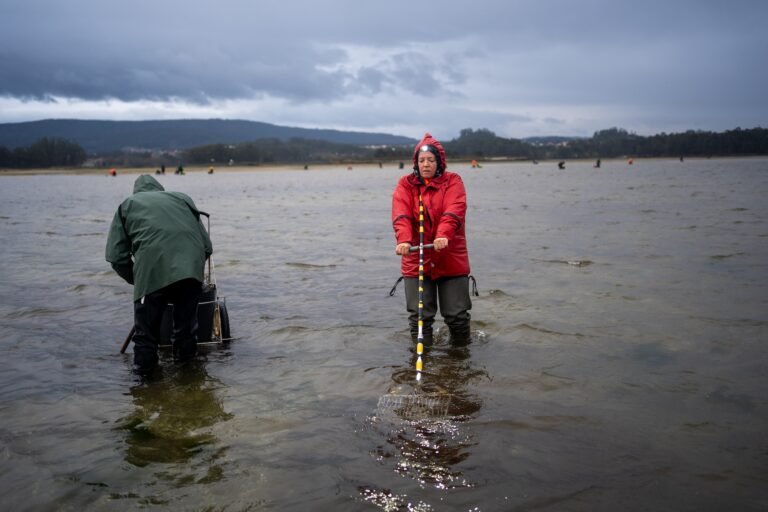In northern Spain, climate alternate is killing shellfish — and females’s livelihoods
Private investigator near me:
- In Galicia in northwestern Spain, shellfish harvesting is traditionally females’s work.
- However the clams and cockles the shellfish pickers’ livelihoods rely upon are extra and extra tougher to return by.
- Coarse weather occasions made extra frequent and intense by climate alternate, including heat waves and torrential rain, threaten the four main shellfish species harvested within the distance, and with them, the tradition that has been handed down thru generations of females.
Reporting for this memoir changed into supported by Journalismfund Europe below the Earth Investigations Programme.
GALICIA, Spain — The first sleepy rays of morning gentle are beginning to illuminate the seaside of Cambados, a miniature Atlantic-going thru town within the Spanish space of Galicia that’s well-liked for its shellfish and Albariño wine. It’s a moist morning in March and the mariscadoras — females shellfish pickers — are wading straight into the ocean armed with buckets and rubber boots for one other day of work.
However the clams and cockles their livelihood is relying on are extra and extra laborious to return by. Coarse weather occasions made extra frequent and intense by climate alternate, including heat waves and torrential rain, threaten varied marine species within the distance, and with them, the tradition that has been handed down thru generations of females.
“Both the shellfish adapt, or they die, and us too,” says Patricia Piñeiro between wind gusts and rain as she searches for clams wide sufficient to harvest.
“They’re comely too miniature,” she says, showing the measuring instrument from the local fishing authorities space to 4 centimeters (1.5 inches), which method she must return a range of the clams she finds to the ocean.
“At this tempo, the almeja fina [[Ruditapes decussatus] and almeja babosa [[Venerupis corrugata] will move,” says Maria José Cacabelos Domínguez, a retired mariscadora who now organizes excursions for folks looking out to seem the shellfish pickers in motion.
Most mariscadoras are between 40 and 60 years musty and began out decades ago when shellfish shares had been silent great. It’s without a doubt one of the most few jobs that can even be mixed with caretaking tasks on this silent-old and patriarchal space, says Sandra Amézaga, the spokesperson of Mulleres Salgadas, an affiliation of females within the fishing sector. The shortcoming of shellfish is now pushing many to plan terminate precarious, informal jobs cleansing hotels or working in bars, she adds.
Shellfish in rapid decline
Moreover sustaining livelihoods, shellfish play a vital role in regulating marine ecosystems. As filter feeders, they super the water they dwell in by eliminating nitrogen, phosphorous and carbon, making them an environmentally sustainable source of nutrient-dense protein.
A 2023 glance from the local University of Vigo shows that the four main species of clams and cockles harvested in Galicia, including almeja babosa and almeja fina, are already in moving decline. While the non-native almeja japónica (R. philippinarum), launched for its adaptability, has proved to be extra resilient to rising temperatures, it, admire the others, is at threat of prolonged sessions of low salinity brought about by heavy rains.
In 2023, comely before Christmas — the most profitable season for shellfish — strangely heat temperatures coupled with intense rainfall brought a pair of mass mortality tournament that reportedly killed spherical 95% of Galicia’s cockles (Cerastoderma edule) and 75% of almeja japónica. Local executive fish market data present a steep decline in shellfish sales following the December occasions, and shares silent haven’t recovered.
Offshore to the north, on Illa de Arousa, shellfish pickers face the an identical fight. “The few clams we space up to search out aren’t rising,” says Inmaculada Rodriguez, head of the local mariscadora affiliation, who began shellfishing alongside her mother and aunts when she changed into 14. “I be aware pulling out clams the scale of my fist.” Nowadays, spherical 3,500 shellfish pickers withhold a license to characteristic, half of as many as in 2001.
Following the disastrous December, a range of Galicia’s shellfish associations temporarily ceased actions to aid shares get better. That involves the mariscadoras from the nearby town of Vilanova de Arousa, who haven’t worked since. They now salvage a limited extra than 1,000 euros ($1,073) a month in executive toughen, says María José Vales Martínez, who beforehand headed the city’s fishing guild. Alternatively, the requirements are strict — these working a second job are in most cases denied compensation — and payments are in most cases delayed, Amézaga says.
While the 6 billion euro ($6.43 million) European Maritime, Fisheries and Aquaculture Fund is alleged to “guarantee … the livelihood of coastal communities,” the extra than 1 billion euros ($1.07 million) given to Spain isn’t reaching the artisanal producers most in want, in preserving with Amézaga. The shellfish pickers Mongabay spoke to order advanced application processes create the funds laborious to access no topic particular guidelines bringing up that EU countries “must endeavour to introduce simplified procedures for miniature-scale coastal fishing corporations applying for EMFAF toughen.”
Rodriguez and her fellow mariscadoras of Illa de Arousa had been among the final to forestall working, and so they’re now within the strategy of applying for monthly executive toughen. At the second, they’re struggling to make a decision even 1 kilogram (2.2 pounds) of almeja japónica.
“What method you method with 1 kilo [of clams]? It’s most likely you’ll per chance per chance’t even pay your social security charges on the end of the month,” Rodriguez says. “[A] lot of folks accept already left to circulation work on land because here is unsustainable.”
Heavy rains and rising temperatures
Mass mortality occasions such because the one in December are inclined to develop into extra total as global warming disrupts rainfall patterns. “Right here in Galicia, we’re mature to the rain. The predicament is when that rain accumulates over a pair of days,” says Elsa Vázquez, a University of Vigo zoologist who stories how changes in salinity and temperature affect the first shellfish species harvested in Rías Baixas, the four productive estuaries in southwestern Galicia.
Torrential rainfall will improve the quantity of freshwater flowing from the river mouths into the estuaries, where the shellfish banks are located. Prolonged sessions of low salinity affect bivalves’ capacity to breathe, feed, grow and reproduce. Shellfish can terminate their valves all the method thru sessions of low salinity to defend themselves, however this makes expend of up precious energy and weakens them, Vázquez says.
Between October and November 2023, Galicia’s weather agency recorded extra than 30 consecutive days of rainfall yielding extra than 1,000 liters of rain per sq. meter (264 gallons per 10.7 sq. toes) — 127% extra than commonplace. “In step with our experiments, salinity below 15 parts per thousand for lots of days causes mortality, and this winter there had been many days when salinity changed into as low as 5 parts per thousand,” Vázquez says.
The emptying of reservoirs all the method thru low tide by electricity corporations also alters the estuaries’ fine balance. In step with the Platform for the Defense of the Ría de Arousa, a conservation NGO, the open of water must be timed to coincide with excessive tide to steer clear of freshwater inundating the shellfish banks.
As caring as low salinity are marine heat waves, that are inclined to space off mass mortality occasions affecting an rising resolution of species and habitats, the EU’s Copernicus weather institute says. In both August 2023 and January 2024, the arena’s ocean temperatures reached an unparalleled realistic of 21.1°C (70°F), a clear mark of global warming with vital implications for biodiversity.
Intertidal shellfish species bury themselves within the sand to withhold chilly, however with heat waves changing into extra intense the warmth penetrates deeper, making it impossible to accept away. Any survivors are severely weakened, which impacts their growth and reproductive ability, Vázquez says.
Diversified variables, such as sea level rise and air pollution from local industry, also play a job. Every centimeter (0.39 trail) of sea level rise method a loss of about half of a meter (1.65 ft) of coastline, submerging sandbanks for longer, says Silvia Torres López, an oceanographer on the Centro Tecnológico del Mar, a research institute in Vigo. “Air pollution is silent a wide unknown. … We wish to withhold monitoring all these factors,” she says. Plans to manufacture a textile factory within the distance, which shellfishers and ecologists pain could per chance extra wound the ecosystem, are within the interim being debated in Galicia and on the EU level.
A bunch of shellfish pickers urged Mongabay they wish the Galician executive to fund an in-depth glance on the impacts of climate alternate to aid present capacity solutions. Scientific objects counsel 2060 is on the total a world tipping point for shellfish in many regions of the arena, with fisheries in Spain at excessive threat due to low species diversity and vulnerability to elevated temperatures.
The near of clam hatcheries is on the total an answer. While some business hatcheries exist for almeja japónica, rising toddler clams to be planted out on sandbanks, extra research is indispensable to cultivate almeja fina and babosa profitably, Vázquez says. She describes this as “the method ahead for shellfishing” for its capacity to put sufficient reproducing adult shellfish to accept shares help to commonplace.
One other solution being explored is the right-time monitoring of salinity, temperature and other variables within the shellfish banks. This is in a position to per chance help researchers accept predictive objects so mariscadoras could per chance put together for sessions of low salinity and excessive temperatures, Vazquez says, adding that it would require devoted executive funding and toughen.
With the warmth summer season months at hand, the mariscadoras are left with the few kilos of almeja japónica they space up to search out. Vales Martínez has worked as a mariscadora for twenty-four years, comely admire her mother and grandmother before her. However admire a range of her colleagues, she’s alarmed in regards to the future.
“What’s in actuality vital is to make investments within the ocean, even supposing it method closing it for a Three hundred and sixty five days whereas shares get better,” she says. ”We wish to address the foundation causes of the predicament, because if the estuary dies, we all die.”
Banner image: A mariscadora makes expend of a clam rake to dredge for shellfish off Cambados in Galicia. Image by Naomi Mihara for Mongabay.
Can Spain withhold the rising sea from washing away a extreme delta?
Citations:
Domínguez, R., Olabarria, C., & Vázquez, E. (2023). Overview of risks linked to indecent climate occasions in miniature-scale bivalve fisheries: Conceptual maps for resolution-making in preserving with a overview of most fresh stories. Journal of Marine Science and Engineering, 11(6), 1216. doi:10.3390/jmse11061216
Carss, D. N., Brito, A. C., Chainho, P., Ciutat, A., de Montaudouin, X., Fernández Otero, R. M., … Jones, L. (2020). Ecosystem companies provided by a non-cultured shellfish species: The total cockle Cerastoderma edule. Marine Environmental Look at, 158, 104931. doi:10.1016/j.marenvres.2020.104931
Des, M., Fernández-Nóvoa, D., DeCastro, M., Gómez-Gesteira, J., Sousa, M., & Gómez-Gesteira, M. (2021). Modeling salinity descend in estuarine areas below indecent precipitation occasions within a context of climate alternate: Create on bivalve mortality in Galician rias Baixas. Science of The Total Ambiance, 790, 148147. doi:10.1016/j.scitotenv.2021.148147
Stewart‐Sinclair, P. J., Final, K. S., Payne, B. L., & Wilding, T. A. (2020). A world evaluation of the vulnerability of shellfish aquaculture to climate alternate and ocean acidification. Ecology and Evolution, 10(7), 3518-3534. doi:10.1002/ece3.6149
FEEDBACK: Employ this develop to ship a message to the editor of this publish. At the same time as you choose to want to publish a public observation, you would possibly want to method that on the bottom of the web page.





